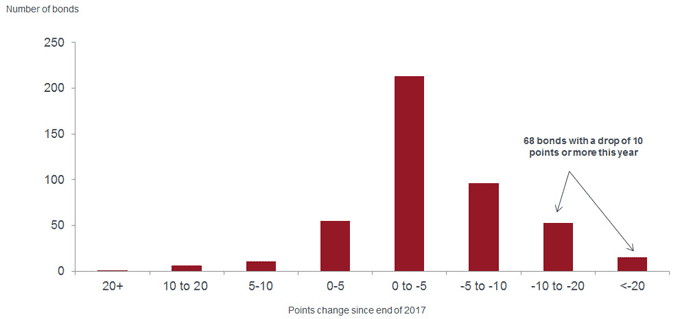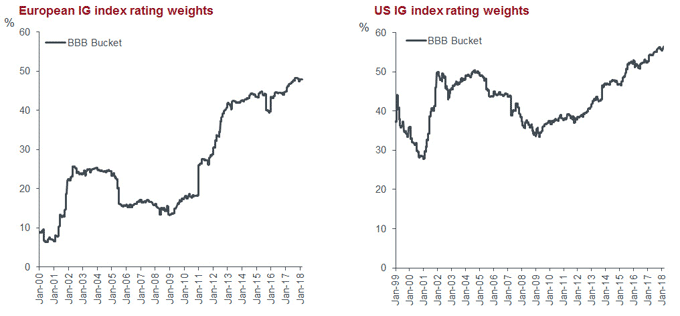
Janus Henderson: Credit selection in a late-cycle environment
Rebecca Young, Portfolio Manager within the Strategic Fixed Income team, shares her views on the topical issues in credit markets, explaining where she and the team see risks and opportunities.
22.11.2018 | 12:30 Uhr
Economies do not grow evenly; there are ups and downs as an economy moves through the different stages of expansion (growth) and contraction (recession). Business activity follows the same patterns. The latest global economic expansion began nearly ten years ago and we firmly believe it is ‘late stage’, although it would appear that we are far from alone in this view. A record 85% of investors surveyed in a recent fund manager survey* think the global economy is in late cycle (11% higher than the previous high in December 2007).
Late-cycle can be a difficult time for credit investors as spreads tend to widen, completing a bottoming process ahead of a peak in equity markets. Hence we need to be vigilant to minimise the downside risk for any of our individual credit holdings. When looking specifically at the developed world credit markets, there are certainly a number of trends worth monitoring closely, and these are currently warning us to tread carefully.
Beginning with global leveraged loans…
Leveraged loans are loans to heavily indebted companies. The Bank of England recently warned that the leveraged loan market is now “larger than — and growing as quickly as — the US subprime mortgage market was in 2006”. Leveraged loans continue to benefit from their senior, more defensive position in the capital structure. However, the legal protections for investors to be able to hold borrowers to account should the financial performance of a business falter, have been significantly eroded, with nearly 80% of the US leveraged loan market now ‘covenant-lite’. This is up from less than 25% in the 2006-07 era.
We have witnessed leverage levels creeping higher and ‘loan-only’ structures becoming more prevalent. These are structures that lack a junior high yield bond component, which would normally provide loss absorption in the event of a default.
Thus, it is not surprising that the average credit quality of the US market has deteriorated, with approximately 64% of the outstanding stock now rated mid single B or below, versus 47% of the market in 2006.
…switching to bonds and the high yield market
In Europe this year, we have been monitoring the rising level of dispersion, with a growing number of individual bonds experiencing large price drops. There are now nearly 70 bonds year-to-date that have dropped 10 points or more (figure 1). Avoiding these large potholes has been crucial for capital preservation. Interestingly, the ICE Bank of America Europe High Yield Index return has held up relatively well, declining 1.4% year-to–date (to 31 October 2018, in local currency terms), but when you dig down a little deeper under the surface, things are not as healthy as they first appear.
Figure 1: European high yield market: change in bond prices year-to-date

Source: Bank of America Merrill Lynch, Bloomberg, as at 30 October 2018
Next: the growing size of BBBs
Another frothy area of the credit market that has caught our attention is the growing size of BBB-rated debt (the lowest tier of investment grade). This phenomenon has played out across Europe and the US in this cycle, including where companies have voluntarily added debt to their balance sheets through merger and acquisition (M&A) activities.
The primary concern here is one of relative size of the BBB market versus the BB-rated category (the higher credit rating bucket of the junk bond market); where, for example in the US, the former is 4.3x the size of the latter and compares to twice the size ten years ago.
The rapid growth of BBB markets in Europe and the US can be seen in figure 2. In the next downturn, there will inevitably be some downgrade activity from BBB to BB but will the BB category suffer from indigestion as it is forced to absorb these downgrades?
Figure 2: Rapid growth of BBBs

Source: Credit Suisse, as at March 2018
So where can we take shelter in the credit markets?
Given this backdrop for credit, we have felt it prudent to gradually upgrade the quality of the portfolios over the past few years, with a preference for higher quality credit and government bonds at the expense of high yield credit.
One theme we continue to favour is that of ‘rising stars’; companies where we are confident in the health of the underlying business, and which are also transitioning from high yield to investment grade. Over this journey, credit spreads tend to tighten and bond prices rise, providing a potential income and capital appreciation opportunity.
An example of this dynamic is CyrusOne, a US-listed data centre company that was recently upgraded to BBB by Standard & Poor’s. The company is laser-focused on getting a second upgrade at Moody’s, motivated by the potential to drive down their cost of borrowing. Two investment grade ratings provide for a positive technical backdrop as bonds see demand from a whole new buyer base since the securities become investment grade index eligible.
Tesco is another rising star example, recently obtaining their first investment grade rating from Fitch, and the company has been actively tendering for bonds in the market to strengthen its balance sheet.
‘Strategic assets’ is another theme of note, specifically companies where we are comfortable with the business fundamentals but also think there is potential for a positive catalyst through M&A activity. For example, our holding in the high yield German cable company Unitymedia, which benefited earlier this year when Vodafone agreed to buy the company. The news sent Unitymedia bond prices higher given that the bonds will be absorbed into the higher quality, investment grade capital structure at Vodafone, on closing of the deal.
In summary, credit-positive stories are certainly becoming harder to find in this late-cycle environment but they do still exist. Thus, we continue to spend our time trying to seek out these opportunities and remain highly selective in terms of the credits we add to our portfolios.
* Bank of America Merrill Lynch Global Fund Manager Survey, 16 October 2018




Diesen Beitrag teilen: